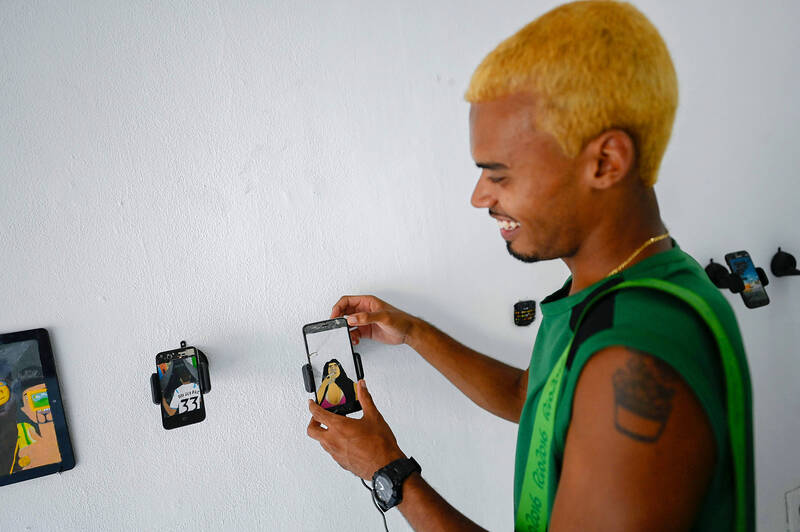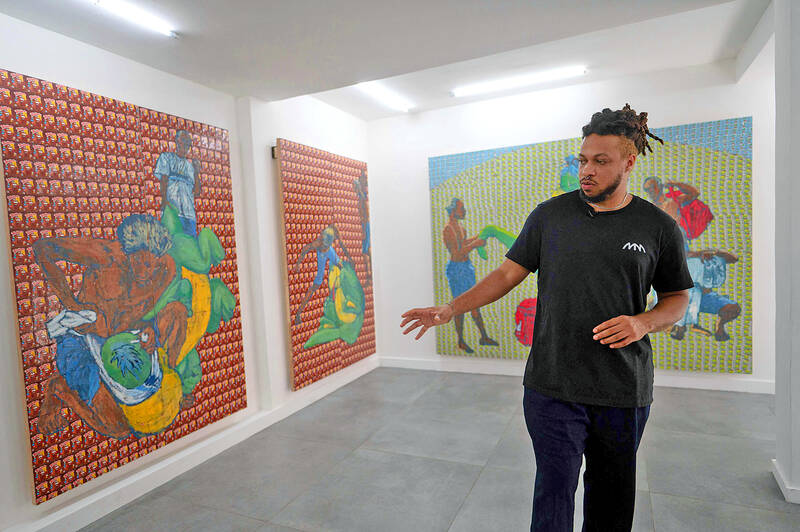Brazilian artists are opening galleries in the drug-and violence-riddled favelas of Rio de Janeiro.
-
AFP, Brazil
Like in most cities, Rio’s galleries are concentrated in its affluent neighborhoods. But artists like Maxwell Alexandre are trying to change that, hoping to “give access to what was previously the art of the bourgeoisie, something exclusive,” the 33-year-old said.
Alexandre grew up in the shantytown of Rocinha, Brazil’s second most populous favela, and where he opened the Pavilhao 2 display space last year. At the moment, he is exhibiting a collection of his own works that last year was on display at a gallery in the exclusive sixth arrondissement of Paris, France.
Entitled Entrega: one planet. one health, the exhibit includes paintings of daily life in Rocinha.

Photo: AFP
A series of three works shows children dressed in school uniforms carrying bags from a food delivery company: a commentary on pervasive child labor.
Another aim of Alexandre — who has also exhibited in Spain and the US — is to make favela residents art owners.
“I want people who live in the favela to see my work not only in the gallery but also at home,” he said.

Photo: AFP
Alexandre is selling his works at the below-market price of about 1,000 reais (US$200) apiece though even this may be a high ask of many.
ART POWER
The gallery also aims to draw visitors from outside, such as 45-year-old teacher Mariana Furlonis, who said: “It’s great, because art is usually very elitist.”
Alexandre acknowledges that most visitors do not come from the favela, whose impoverished inhabitants have other, more pressing priorities.
But though he is often advised to focus his efforts on such artistic hubs as Berlin or New York, Alexandre prefers to stay in Rio, where he says his creativity is inspired by the heat, the violence, the omnipresent poverty.
About 30 kilometers away, fellow artist Allan Weber, 31, opened a gallery in his childhood favela, Cinco Bocas, in 2020.
His works had recently been exhibited at the Miami contemporary art fair Art Basel.
Back in Rio, he uses his gallery to give exposure to lesser-known local artists.
“It’s a place of exchange between the favela and people who come from elsewhere,” he said.
His target clientele are people like himself who grow up without access to downtown museums, but also more affluent friends reluctant to visit the favelas, frequent targets of heavy-handed police operations.
“I spent all my childhood seeing weapons, and thanks to art, I was able to give them a new meaning,” Weber said.
One of his creations is an assault rifle made from camera parts.
‘NO PLACES LIKE THESE’
Since last September, Weber’s gallery has hosted an exhibition entitled “To de Pe” (I am standing) by 22-year-old Cassio Luis Brito da Silva.
The youngster’s creations include photos of evenings of “Baile funk,” a musical style born in the favelas, and sculptures made with cigarettes. Da Silva, a favela resident himself, said being exposed to the work of other artists at the gallery serves as an inspiration.
“It is wonderful to see people like me exhibit in this place,” he says.
At Cinco Bocas, Weber encourages visits from disadvantaged youngsters from the favela.
Cintia Santos de Lima, 35, says her autistic son has benefited from the initiative.
“Before, he didn’t want to go out. It is good for us because in the community there are no places like these.”
Comments will be moderated. Keep comments relevant to the article. Remarks containing abusive and obscene language, personal attacks of any kind or promotion will be removed and the user banned. Final decision will be at the discretion of the Taipei Times.
This post was originally published on this site be sure to check out more of their content







